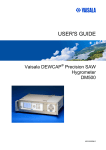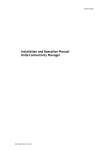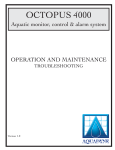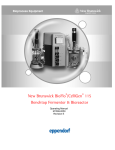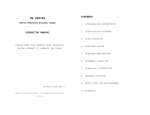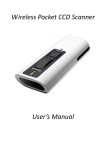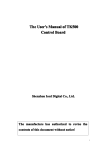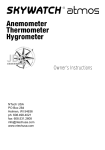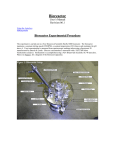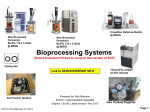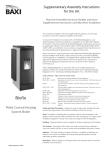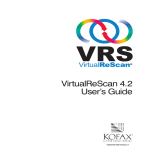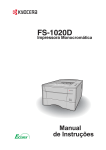Download View Manual
Transcript
Fermentor Control Program, manual version released 15 February, 2005 Fermentor Control Program BioStat A, B, C, D, CT, MD, DCU, and Micro-DCU (200, 300) Systems BioFlo III, 2000, 3000, 4000 and 110 Systems See www.foxylogic.com for other systems Version 4.3 February 2005 FoxyLogic, PhD, MSc Mikkel Holmen Andersen, Aarhus, Denmark Email: [email protected]. Program homepage: www.FoxyLogic.com 1 Fermentor Control Program, manual version released 15 February, 2005 Table of contents Introduction ..............................................................................................................................5 System requirements................................................................................................................5 Access Database Version ......................................................................................................5 Installing the Fermentor Control Program ...........................................................................5 Un-installing the Fermentor Control Program .....................................................................6 About time and time resolution in windows systems ............................................................6 IMPORTANT: ......................................................................................................................6 About decimal symbol in windows systems ...........................................................................6 Fermentor settings....................................................................................................................6 BioStat Fermentor ................................................................................................................6 Pump setting .........................................................................................................................7 Communication port setting ...............................................................................................7 Communication test tool......................................................................................................7 BioFlo Fermentor..................................................................................................................8 Loop and pump settings for BioFlo....................................................................................9 The main control window ......................................................................................................10 Control window...................................................................................................................10 Time panel ...........................................................................................................................11 Status bar.............................................................................................................................11 The database system...............................................................................................................12 Database Tools ....................................................................................................................14 Administrator Tool .............................................................................................................15 Historian Database Layout ................................................................................................16 The graph window..................................................................................................................17 Synoptic process data window ..............................................................................................18 Profiles module .......................................................................................................................19 Profile editor........................................................................................................................19 Fuzzy logic control module....................................................................................................20 Fuzzy logic rule matrix.......................................................................................................20 Running the fuzzy logic module.........................................................................................23 The software substrate sensor...............................................................................................24 FoxyLogic, PhD, MSc Mikkel Holmen Andersen, Aarhus, Denmark Email: [email protected]. Program homepage: www.FoxyLogic.com 2 Fermentor Control Program, manual version released 15 February, 2005 Sampling Training Data ....................................................................................................25 How much data are needed ? ............................................................................................25 The sensor training tool......................................................................................................26 Using the substrate sensor.................................................................................................27 Current Input Parameters ................................................................................................28 pH Stat.....................................................................................................................................28 Probing Feeding Control .......................................................................................................29 Scripting Module ....................................................................................................................30 Alarm Module.........................................................................................................................31 Option settings ........................................................................................................................33 data sampling rate...............................................................................................................33 TCP/IP client control .............................................................................................................34 Host setup ............................................................................................................................34 Firewall issues......................................................................................................................34 Client setup ..........................................................................................................................35 Saving Collected Data to file .................................................................................................35 Log files ...................................................................................................................................36 Further information...............................................................................................................36 Appendix .................................................................................................................................37 Rule Matrix Sheet ...............................................................................................................37 Profile Editor file layout.....................................................................................................38 Fuzzy logic control file layout ............................................................................................38 RuleSub2.fuz.......................................................................................................................38 RuledpO2.fuz......................................................................................................................39 RuleSoftSub.fuz..................................................................................................................40 RulepH.fuz ..........................................................................................................................41 pO2.mf.................................................................................................................................42 dpO2.mf ..............................................................................................................................42 Sub.mf .................................................................................................................................43 dSub.mf ...............................................................................................................................43 SoftSub.mf ..........................................................................................................................44 pH.mf...................................................................................................................................44 dpH.mf ................................................................................................................................45 Software Sensor control file layout ...................................................................................46 Example.nnf........................................................................................................................46 FoxyLogic, PhD, MSc Mikkel Holmen Andersen, Aarhus, Denmark Email: [email protected]. Program homepage: www.FoxyLogic.com 3 Fermentor Control Program, manual version released 15 February, 2005 Sensor.nnf ...........................................................................................................................47 Training data input file .....................................................................................................48 Training data output file ...................................................................................................48 Standard Script.txt .............................................................................................................49 Wiring between RS-422 converter and BioStat fermentor .............................................51 Wiring between PC and BioFlo fermentor.......................................................................52 FoxyLogic, PhD, MSc Mikkel Holmen Andersen, Aarhus, Denmark Email: [email protected]. Program homepage: www.FoxyLogic.com 4 Fermentor Control Program, manual version released 15 February, 2005 Introduction The control and collection software for the research bench top fermentors was made to facilitate and automate some general and time consuming tasks. Initially, the program was made to collect the process data during fermentation and save these for further evaluation in other programs. Soon however, there was also a need for a more user friendly program compared to the on-board fermentor control, and the possibility of a TCP/IP client connection that significantly reduced the on site time, a factor not to be overlooked in a research laboratory. Finally, intelligent control over set points seemed an obvious thing to implement. Together, these goals merged to the development of the current program. To make the program as simple and logical as possible, the amount of choices and possibilities are kept at a minimum. Tool tip texts tell you how to manipulate controls etc. when the mouse pointer is over a given control for more than a second. The final goal is of course to make the present manual useless. Computer system requirements Windows 95/98/NT/2000/XP, min. Pentium processor 333 MHz (more processor power needed for fuzzy logic and neural network modules), min. 64 Mb ram, min. 200 Mb hard disk space, standard PC serial port (RS-232C), converter for BioStat fermentors (RS-232C to RS-422). Serial cable. On Windows 95/98 DCOM95/98 needs to be installed (free from Microsoft). Access Database Version Microsoft Access database program (Access 2000 or newer) is needed to manipulate the process database, if you want to generate batch reports or print data. The database that ships with the Fermentor Control Program is in Access 2000 format. If you want to migrate to Access 2000 or higher, open the BioStatDB.mdb file in Access 2000 and you will be prompted to save in the new database format. Answer Yes to upgrade database. The Fermentor Control Program will recognise both types of format. However, you cannot make a replica of the database with Access 2000 as this is not compatible with the Fermentor Control Program. This is due to a Microsoft backward compatibility policy. Installing the Fermentor Control Program The program is delivered with an Installation and Setup Wizard . To start the wizard run the file called SETUP.exe. After you have downloaded the program unzip the file in a temporary directory before running the SETUP.exe file. If you use a NT, 2000, or XP system be sure to login as administrator before running the SETUP.exe. The installation wizard prompts for an installation directory, and it is recommended that you use the default setting. When the installation is finished, you can be asked to restart your computer. Although annoying, this is normal Windows behaviour. In FoxyLogic, PhD, MSc Mikkel Holmen Andersen, Aarhus, Denmark Email: [email protected]. Program homepage: www.FoxyLogic.com 5 Fermentor Control Program, manual version released 15 February, 2005 some cases, if you have an old Windows 95/98 version, the wizard needs to update your system and restart your computer to continue the installation. This will not affect anything else. A file called St6unst is left in the Fermentor Control Program folder. Do not delete this since the un-installer program uses this file if you wish to remove the program. Un-installing the Fermentor Control Program To un-install the program, use the Add/Remove option found in the windows control panel. Press the Add/Remove button and browse to the Fermentor Control Program entry. Finally, click remove. You may be asked if you want to remove shared files. If so answer NO when prompted. These files are Visual Basic runtime files, which may be used by other Visual Basic encoded programs. About time and time resolution in windows systems Available timer interfaces in Windows have very poor time resolution. This means that the time points are not precisely spaced with the given sample rate (30 sec.), and is partly an effect of event based programming. Nevertheless, to communicate with the fermentor a millisecond resolution is necessary and therefore a special function is used to give this resolution. IMPORTANT: One drawback is that you have to restart your computer every 23 days to reset the function counter. The best thing to do is to restart the computer before every new fermentation run, but that will probably be the normal case anyway. About decimal symbol in windows systems Due to a bug in Microsoft Visual Studio the handling of the decimal symbol is not easily accomplished. The Fermentor Control Program will try to follow the international setting on your computer. To know which decimal symbol to use in files used by the program, have a look at the output files generated by the program and use the same in your own input files (*.MF fuzzy logic, profile, and neural network training files). Also have a look at the text in input boxes, the correct decimal symbols for your system is given there. If you see incorrect data being sampled, try to set your international settings to English. You can do this by going into Control Panel, and then click on International. In the first panel select English, then restart the computer. Fermentor settings BioStat Fermentor Before you start the Fermentor Control host program the fermentor has to be set up for host connection. To do this, go into the MAINTENANCE menu on the fermentor FoxyLogic, PhD, MSc Mikkel Holmen Andersen, Aarhus, Denmark Email: [email protected]. Program homepage: www.FoxyLogic.com 6 Fermentor Control Program, manual version released 15 February, 2005 and step down to the HOST setup. To alter the settings enter the 2-digit password to access the interface parameters. Then set these as indicated below. ADR: SPEED: DATA: STOP: PARTY: 1 9600 7 1 EVEN Finally, press the remote button to ON. The fermentor is now ready to communicate with the host computer. During the fermentation run you can manually manipulate the settings on the fermentor by setting the remote button to OFF. While doing this you are unable to use the computer as controller and the host program will prompt you to set it to ON again. However, data collection will continue, and the Fermentor Control Program will update its controls to match the manually entered changes. Pump setting The current version of the Fermentor Control Program only supports anti-foam for substrate pump 1 and substrate addition for substrate pump 2. Therefore, pumps have to be set to apply with this before the control program is started. Please consult with the operating manual for the fermentor Communication port setting The connection between the BioStat fermentor and the host computer goes trough the standard PC serial port and an RS-232C to RS-422 signal converter. The converter can be bought in most PC or electronic stores for approximately 100$. Please refer to fermentor hardware user manual and the Fermentor Control Program homepage for instructions on wiring or see appendix. When the control program is started, it looks for the serial communication port to which the fermentor is attached. The default port number is 2, as Comm port 1 is usually used for the mouse. If Comm port 2 is not available you will be prompted for another port number (1 to 8). If the given port is free then program continues to search for the fermentor and you can see in the status bar when the host program found it (See also: Status bar). If the status bar continues to display the fermentor is OFF then check that the remote button is ON, the cable is plugged to the right Comm port, and that the converter is working. Restart the program to alter the Comm port number if necessary. Communication test tool If you are experiencing problems in connecting the fermentor to the PC, then you can use the TestComm test tool to check the connection. Download the tool from FoxyLogic.com, place it in the Fermentor Control Program folder, and run the program with the fermentor. First the tool looks for available and free serial ports on FoxyLogic, PhD, MSc Mikkel Holmen Andersen, Aarhus, Denmark Email: [email protected]. Program homepage: www.FoxyLogic.com 7 Fermentor Control Program, manual version released 15 February, 2005 your computer. Then you select the port, which the converter is attached to, and press the Test Connection button. Every 2 seconds the program sends a telegram to the fermentor and checks the returned telegram. If the fermentor is correctly setup, a text message will tell you so. If no connection is detected then check you cabling and converter. As a last resort you can contact me by Email: [email protected], but only if you attach the Run.log and Error.log generated by the TestComm tool. BioFlo Fermentors To setup the communication between a computer and the fermentor a protocol has to be used. BioFlo III, 2000, and 3000 fermentors: To enable the right type of protocol you need to open the back of your fermentor and change the settings of the micro-switch S1 as follows (Consult you instrument manual to locate the switch): Settings of switch 1 (S1) on the fermentor control board 1. S1-1 and S1-2 are used for setting the baud rate: Baud Rate S1-1 S1-2 9600 OFF OFF (factory setting) 2. S1-3 is used for setting the parity check: Parity S1-3 Even ON 3. S1-4 is used for setting mode: Mode S1-4 non-multidrop OFF 4. S1-5, S1-6, S1-7, S1-8 are used for setting unit number: Unit # S1-5 S1-6 S1-7 S1-8 0 ON ON ON ON (factory setting) Settings of the micro-switch S2 as follows (Consult you instrument manual to locate the switch): 1. S2-1 S2-2 S2-3 S2-4 ON ON ON ON (factory setting) BioFlo 110 Fermentor: For the BioFlo 110 fermentor you need a cable like shown below: DB9 (PC) DB25(BioFlo 110) 2 ---------------- 2 3 ---------------- 3 5 ---------------- 7 On the BioFlo 110 box set the Base Address to "Zero" on the fermentor (see Manual page 70; 5.3.3) and select AFS mode as protocol. Set the subunit addresses to unit 1 FoxyLogic, PhD, MSc Mikkel Holmen Andersen, Aarhus, Denmark Email: [email protected]. Program homepage: www.FoxyLogic.com 8 Fermentor Control Program, manual version released 15 February, 2005 Loop and pump settings for BioFlo 2000/3000/4000 and Before you start the Fermentor Control Program you may need to manually setup the use of pumps on the BioFlo fermentor in the right order. Thus, Acid, Base, Antifoam, and Substrate needs to use the indicated pumps as shown below. If not, the values and setpoint on the fermentor are not recognised properly by the Fermentor Control Program: Feed 1 for Acid Feed 2 for Base Feed 3 for Antifoam Feed 4 for Substrate Finally, when you start the Fermentor Control Program for the first time you need to change the fermentor type from the default BioStat fermentor to a BioFlo fermentor type. This is done in the Options menu. FoxyLogic, PhD, MSc Mikkel Holmen Andersen, Aarhus, Denmark Email: [email protected]. Program homepage: www.FoxyLogic.com 9 Fermentor Control Program, manual version released 15 February, 2005 The main control window The main control window allows you to control and set up the fermentor before and during a run. The menu bar contains the functions and setup programs needed to start, stop, save data, enable TCP/IP remote connection to the client program, edit profiles, and to control the fuzzy logic and software sensor modules. Some of these menus are only available during time when a batch is running. All batch and process data is stored in a Access database also. Control window The control panel is where you can manipulate set points on the fermentor. As shown in the figure, using the graphical sliders and ON/OFF buttons above them does this. For example, to set agitation to ON click the OFF button, which then shifts to AUTO. A tool tip text also tells you how to change it. The slider below is enabled and with the mouse or keyboard (page up/page down/arrows) you can set the new set point. Below the slider there is a numerical display that indicates the current set point. When you change to the given set point, the number turns red. Once accepted by the fermentor it turns green again. Be aware that this can take up to 30 seconds. The value is set immediately, but the program only checks all actual set points every 30 seconds. A special case is when the pO2 level is set. The host program uses agitation to control FoxyLogic, PhD, MSc Mikkel Holmen Andersen, Aarhus, Denmark Email: [email protected]. Program homepage: www.FoxyLogic.com 10 Fermentor Control Program, manual version released 15 February, 2005 the level of dissolved oxygen in the fermentation tank. When you click the pO2' button the stirr-slider is disabled and the stirr-button displays the text pO2 Casc , meaning that oxygen cascade controls the agitation. When you turn off the pO2 again, the stirr control is enabled and left at the last setpoint given by the pO2 cascade control. The current version of the Fermentor Control Program only supports addition of antifoam by the substrate pump 1. Therefore no slider control is available for this pump. It has to be setup manually on the fermentor prior to a run. The actions of the pump are being logged during the run and are stored in the collection data file. Time panel This is an information only panel. When the program is started only the current date and time are shown. Once you initiate the fermentation run, the start date and time is registered. These are saved in the log files and the collection data file together with the user name. At the top a timer is started displaying the elapsed fermentation time. The profile module as reference timer uses this counter. Status bar The status bar gives you an up-to-date view of the state of several interfaces. First, it tells you whether the TCP/IP is open, closed, or listening (See TCP/IP client control). It also tells you what IP-number the host computer has. And it shows you if the connection to the fermentor is on or off, and finally, you can see the current user logged in and the name of the batch owner. Holding the mouse pointer over each box in the status bar a tool tip texts will be displayed to tell you which is what. FoxyLogic, PhD, MSc Mikkel Holmen Andersen, Aarhus, Denmark Email: [email protected]. Program homepage: www.FoxyLogic.com 11 Fermentor Control Program, manual version released 15 February, 2005 The database system Starting from version 4.0 a new database system has been introduced. The program utilises the widely used Microsoft Access database for the storage of user, batch, and process data. This data is then available for historical investigation using up to date database technology. Furthermore, all data are easily available for the software substrate sensor during training (a future automatic feature). The database is built up of three sub-databases: a user, batch, and a process database. These are linked together by unique UserIDs and RunIDs to form what is called a relational database system. When the program is started you will have to login to the database. This is done by selecting the User/Batch menu and selecting User LogOn . A window as below will be shown. You can create a new user profile by clicking Create New User or simply log in as default user (Password: 111). New users are by default set to have Batch Owner access rights. FoxyLogic, PhD, MSc Mikkel Holmen Andersen, Aarhus, Denmark Email: [email protected]. Program homepage: www.FoxyLogic.com 12 Fermentor Control Program, manual version released 15 February, 2005 Once a user is logged in to the database, the menus Batch Start/Stop and View Batch Data becomes available. To start a batch select the Batch Start/Stop submenu Start Batch Run . Likewise, stopping of a batch is done by selecting End Batch Run . In the View Batch Data menu you can choose to display the currently running batch data as well as old batch data. You are only allowed to see and edit data for which you are logged in. The window shown below allows you to display and edit batch information such as stain, media, and product information. Only the specific Batch Owner can stop and edit the batch data. In this window the Run log is also shown. You have the possibility to synchronize your fermentations to a certain time point for example at inoculation or when induction of recombinant protein is induced. Press the synchronize button and the Batch Age counter in the Batch information window with reset and count from that moment. You are only allowed to set the synchronization time once during a batch. By clicking the View Process Data button you can see the batch specific process data in table format as shown in the figure below. Both collected, derived, and offline data can be edited for the current and finished batches. FoxyLogic, PhD, MSc Mikkel Holmen Andersen, Aarhus, Denmark Email: [email protected]. Program homepage: www.FoxyLogic.com 13 Fermentor Control Program, manual version released 15 February, 2005 Three offline data sets are currently available named: OFF-LINE DATA1, OFF-LINE DATA2, OFF-LINE DATA3. In the Options menu you can change these names by names that reflect better the data type you are entering (See Option Menu below). To enter or edit offline data, click on the Edit Off-line Data button. This will disable the updating of the process data table to give time to edit the data points. Once you are done, click on the same button and the data will be updated to the database and data collected meanwhile will be displayed. At any time you can export processes data to a file in XML file format. This format is widely accepted by other software. Database Tools In the File menu several database tools are found. The other 3 are all for maintaining the database. These functions are only available when the program has just been started, and for users with Administrator access rights. Extract Training Data will be discussed below in the software sensor section. Compact Database will clean up the database and results in a small and faster database file. You should perform this operation every five fermentation runs. Backup Database simply takes a hard copy of the BioStatDB.mdb file and stores it at the place you select. New Database is the most time consuming tasks and is only recommended when the database is getting very large. The Access database has an upper size limit of 2Gb. Therefore you need to export process data out of the database and store this in another FoxyLogic, PhD, MSc Mikkel Holmen Andersen, Aarhus, Denmark Email: [email protected]. Program homepage: www.FoxyLogic.com 14 Fermentor Control Program, manual version released 15 February, 2005 database. The New Database performs this task. It accumulates new user, batch, and process data in the BioStatDBBackup.mdb files and deletes process data from the BioStatDB.mdb file. This process is time-consuming and could be left to run during the night. For example, it takes 20 minutes to move data from four 5-day fermentations. In the Main Control Window , a progress bar will show you how much data have been moved (0 100%). When the BioStatDBBackup.mdb gets near the 2 Gb size limit, this in turn is backedup automatically and given a date extension to the file name (ddmmyy, e.g. BioStatDBBackup010102.mdb). A new accumulative BioStatDBBackup.mdb file is then created. A copy of the old User and Batch information is kept in the BioStatDB.mdb file to provide data consistency (unique User and Run ID s). This means that you can later combine all BioStatDBBackupddmmyy.mdb database files into one big historian database, if you have access to MS/SQL Server, MySQL, or similar programs that can handle very big databases. Administrator Tool Like the database tools, this function is only available when the program has just been started. After the first log in access is disabled. The tool is used to control user access rights to the program. There are 3 levels of user-rights, each with different access rights associated with them. Program Functions Start/Stop Batch View Batch/Process Data Edit Batch/Process Data Changes Process Setpoints Profile Editor Settings Fuzzy Logic Settings Substrate Sensor Settings Internet server Settings Change Options Database Tools Edit User Rights Batch Observer Batch Owner Administrator Selecting the Administrator Tool menu will result in a prompt for a password. This password can only be obtained from me by sending a request by Email. Passwords will only be given to persons who have registered with a valid Email address, when downloading the Fermentor Control Program. After entering the password you will be shown a window in which all users in the database are listed. A selection panel with Batch Observer , Batch Owner , and Administrator options are shown to the right. Select the user then the access rights FoxyLogic, PhD, MSc Mikkel Holmen Andersen, Aarhus, Denmark Email: [email protected]. Program homepage: www.FoxyLogic.com 15 Fermentor Control Program, manual version released 15 February, 2005 and click Set User Rights . Historian Database Layout New Database BioStatDB.mdb Copy User, Batch and Process Data Delete Process Data If size ~2 Gb Copy Database BioStatDBBackup.mdb New Database BioStatDB.mdb BioStatDBBackup010102.mdb BioStatDBBackup.mdb BioStatDBBackup.mdb FoxyLogic, PhD, MSc Mikkel Holmen Andersen, Aarhus, Denmark Email: [email protected]. Program homepage: www.FoxyLogic.com 16 Fermentor Control Program, manual version released 15 February, 2005 The graph window In this window the collected data are shown in a simple XY-scatter plot. Checking the corresponding check box beside the graph display chooses the different graphs of process data. All graphs are shown as default. On the other side the graph scale is shown. For simplicity it is divided into two different scales and you can change between them by clicking on the scale. A tool tip text also tells you how to change it. Below the graph selection box there is a window which shows the position of the mouse pointer when this over the graph area. If the pointer is over a data point the value of that point is shown together with the time of it. In the menu of the graph control, you can change the layout of the graph window. The scaling of the volume and the time axis can be changed. Furthermore, you set how many of the obtained data point you wish to see. Finally, you can chose to print the displayed graph at any point during the fermentation run. Only the curves shown in the graph will be printed on the default Windows printer. The resolution is not terrific and the option is only intended for preliminary analyses and simple data inspection, whereas the saved data file can be used in any spreadsheet program most of which have excellent graph options. From version 3.0 of the program, an extra graph has been added. This graph shows the predicted substrate concentration. By using the software substrate sensor module, current process values are used to predict the substrate concentration in the fermentor broth (See Software Substrate Sensor). If the module is in use, you can enable the graph. The data are shown in an insert graph with a time window of 60 minutes. The FoxyLogic, PhD, MSc Mikkel Holmen Andersen, Aarhus, Denmark Email: [email protected]. Program homepage: www.FoxyLogic.com 17 Fermentor Control Program, manual version released 15 February, 2005 graph is self-scaling. Use this graph to inspect the correctness of the software substrate sensor. If you see large differences sample more training data for this fermentation phase. Synoptic process data window A window showing all recent process data in a synoptic display as shown below has been added. The latter window is for information only. The status of the pumps and volume levels are shown. The predicted substrate concentration is only shown when the software sensor is turned ON. The levels of liquid in the fermentor tank and supply tanks are changing to reflect the process data sampled. For this to work best, you have to enter data for your specific fermentor setup. This only has to be done once in the Vessel and Supply Tank settings found in the Set Options menu. FoxyLogic, PhD, MSc Mikkel Holmen Andersen, Aarhus, Denmark Email: [email protected]. Program homepage: www.FoxyLogic.com 18 Fermentor Control Program, manual version released 15 February, 2005 Profiles module The profile module is a significant improvement of the Fermentor Control Program. With this control you can design timed programs, by which the fermentor should follow. Since you are not around 24 hours a day, this control will let you change setting points at any time during a fermentation run. The elapsed fermentation time is used as reference time. Profiles are turned on by selecting the profile enabled entry point in the Profiles menu. Profile editor Profiles can be created when the fermentor is running. By selecting the Edit Profile menu point a window as seen below is opened. Here you select, the time when you want the change to take place, the control you want to change, and finally you set the set point. When this is done, click the Add Entry button and the new entry will appear on the list. In the file menu you can both save profiles and load old once. If a wrong action is in the list, you simply click on the entry in the list and then press the Delete Entry button. Entries that have been executed are shown in green, pending once are red. If you load a profile during a run, actions with time points less that the current elapsed fermentation time will be ignored and shown in green. All actions made by the profile control are logged in the batch database and the RUN.log file. FoxyLogic, PhD, MSc Mikkel Holmen Andersen, Aarhus, Denmark Email: [email protected]. Program homepage: www.FoxyLogic.com 19 Fermentor Control Program, manual version released 15 February, 2005 Fuzzy logic control module Fuzzy logic control is equivalent to have computers reason like humans do, just much faster. Normally, when we think of computers making decisions, the output would be true or false. However, fuzzy logic is a way of letting the computer say little, big, bigger, not so big, and so forth, and have an output decided upon from these vague inputs. Fuzzy logic has some strength over conventional control algorithms like for example Proportional-Integral-Derivative (PID) control. Often biological systems are nonlinear, difficult, or impossible to model mathematically. However, fuzzy logic is empirically based and model-free thus opens doors for control systems that would normally be deemed unfeasible for automation. Furthermore, fuzzy logic is very robust and does not need precise and noise-free inputs to generate usable outputs. Finally, fuzzy logic is not conceptionaly difficult to understand, and it can easily be modified and fine-tuned during operation. Essentially, fuzzy logic revolves around a rule base made of simple, plain-language if X is A and Y is B then Z is C rules. The rules describes the response to a number of inputs (X and Y), which could be pO2, pH etc., and A and B are linguistic variables representing the input values. Although words like large negative, small, and hot are imprecise, they are descriptive of what must actually happen. So instead of making ridged control algorithm, a small number of rules offer a much more flexible control without any mathematical model of the system. This is what experts do when they assist in controlling ill-described systems; by reasoning from prior experience and act accordingly to it. There are several very good tutorials and bibliographies on the Internet, if you are interested in learning more about fuzzy logic. See the program homepage for more information (www.FoxyLogic.com). Fuzzy logic rule matrix So what to do to get the fuzzy logic controller running? First of all, it has to be decided, which parameters can be used for control. For the lab bench fermentors there is little to decide however, since the only thing you have direct control over is addition of substrate. The other parameters are in the hands of the hardware embedded PID control, which does a good job of it. But the collected data can be used as input for the controller that is pO2, dpO2, and substrate set point. In the future other parameters may be added, as they are demanded. Thus, to setup the fuzzy logic control, a rule database made of if X is A and Y is B then Z is C rules is needed (A: pO2, B: dpO2 or substrate setpoint, C: substrate setpoint output). To gather and organise knowledge about the relationship between these FoxyLogic, PhD, MSc Mikkel Holmen Andersen, Aarhus, Denmark Email: [email protected]. Program homepage: www.FoxyLogic.com 20 Fermentor Control Program, manual version released 15 February, 2005 inputs and corresponding output linguistic values, a rule matrix is usually used. By filling in control words like: Positive Large (PL), Negative Medium (NM), and Zero (ZE) the controller knows what to do when a rule is applicable. A rule matrix is organised as follows: If X is A and Y is B then Z is C Y X B Z(C) A Substrate Feed Rate pO2 Very Low Low Ok High Very High Very Low NS NM NM NL NL Low NS NS NS NS NM Ok PM PS PS ZE NS High PM PM PS ZE NM Very High PL PL PM NS NL Very Low (VL), Low (L), Ok, High (H), Very High (VH) and Negative Large (NL), Negative Medium (NM), Zero (ZE), Positive Small (PS), Positive Medium (PM), Positive Large (PL). Take RULE 3 from the figure found on next page: If pO2 is Low and Substrate Feed Rate is High then Substrate Feed Rate is Negative Small. Or in short: If pO2 is L and Substrate is H then Substrate Feed Rate is NS. As you can see it is easy to use the rule matrix to make the rulebase file for the controller program. The above matrix will yield 25 rules, which should be entered into the RuleSub.fuz file. Likewise, the rules for the RuledpO2.Fuz and RuleSoftSub.Fuz files can be created by filling in a rule matrix for each case. The change in Substrate Feed Rate is determined by the values given in the dSub.MF file. Some work must be put into adjusting the values given in controller files, however only the rule files need essential editing to fit your expression system: Sub.MF pO2.MF dpO2.MF Substrate Member Function, converts substrate setpoint to fuzzy value. pO2 Member Function, converts pOxygen setpoint to fuzzy value. dpO2 Member Function, converts dpOxygen setpoint to fuzzy FoxyLogic, PhD, MSc Mikkel Holmen Andersen, Aarhus, Denmark Email: [email protected]. Program homepage: www.FoxyLogic.com 21 Fermentor Control Program, manual version released 15 February, 2005 value. pH.MF pH Member Function, converts pH setpoint to fuzzy value. dpH.MF dpH Member Function, converts dpH setpoint to fuzzy value. SoftSub.MF Member Function, converts predicted substrate concentration to fuzzy value. dSub.MF RuleSub.FUZ dSub Member Function, converts fuzzy value to substrate setpoint. Rules for pO2 and dSub substrate control(DO-stat). RuledpO2.FUZ Rules for pO2 and dpO2 substrate control (DO-stat). RulepH.FUZ Rules for pH and dpH substrate control (pH-stat). RuleSoftSub.FUZ Rules for [Sub] and Sub substrate control. FoxyLogic, PhD, MSc Mikkel Holmen Andersen, Aarhus, Denmark Email: [email protected]. Program homepage: www.FoxyLogic.com 22 Fermentor Control Program, manual version released 15 February, 2005 A schematic drawing of how the controller is working is shown above. The file layout is tabulated and every line starting with an asterisk (*) is ignored. More information about values and file layout is given in the legend of the above files (see Appendix). Running the fuzzy logic module When you turn on the fuzzy logic control a green ON will show in the Fuzzy Control window between the pO2 and substrate slider controls. You can follow the input data (pO2, current feed rate, and dpO2) and the output (change in feed rate). All input and output data, and actions made by the control is logged in the fuzzy.log file (see log files). In the submenu of the under the Fuzzy Logic menu you can decide how often the controller should run. Furthermore, you can turn on and off the different types of fuzzy logic control to run your fermentor in DO-stat mode or in pH-stat mode. FoxyLogic, PhD, MSc Mikkel Holmen Andersen, Aarhus, Denmark Email: [email protected]. Program homepage: www.FoxyLogic.com 23 Fermentor Control Program, manual version released 15 February, 2005 Under the Fuzzy Logic menu you can select which functions should be running and how often. You can also start a test run where the fuzzy logic controller just saves data in the fuzzy.log file. Turning on the test run, no changes to the substrate feed rate is done, so you can see and adjust the performance for the controller without losing your fermentation. If you make changes to the control files (dpO2.mf, dSub.mf etc) or the rule files, you can reset and reload the control with the new settings by selecting the menu Reset/Reload . The software substrate sensor Biological systems are difficult to model largely due to the inherent non-linearity of such systems. However, neural networks can help users to describe and model phenomena that are too complex for analytical methods or empirical rules. Neural networks can efficiently be used to forecast process values in fermentation processes, since they are able to map/describe non-linear functions. In the case of fermentation processes, neural networks are for instance able to forecast the substrate concentration on the basis of inputs such as culture volume, pH, pO2, and current substrate feed rate. Neural networks are used in large-scale fermentation systems to aid the supervisor in keeping the batch in good shape thus maximising the product output. Since this is also the main goal in the research laboratories, a neural network software sensor module has been incorporated into the Fermentor Control Program. The idea behind this addition is to enable researcher to predict the available substrate concentration and also to have a tool to validate off-line substrate concentration measurements. As many expression systems are using the fed substrate to either induce or control the expression of recombinant protein or product, it is of importance to know the free concentration of the substrate. Too low a substrate concentration leads to low expression, and when high overflow metabolism can inhibit cell growth and thus product production. The output from the software sensor can be used as input for the fuzzy logic control module such that the optimum substrate concentration in the fermentation tank is maintained. One of the initial steps towards a successfully working neural network software sensor is to decide on the network layout. On the basis of information from many different sources, a two layered fully connected backpropagation network was chosen: besides input units, one hidden layer and an output layer are forming the sensor network. A sigmoid activation function is used and a threshold term is added to the neuron output function preventing the network to be trapped in a local minimum. Input data are rescaled to values within a range of -1 to 1 and output data between 0.1 and 0.9. Currently 7 inputs are being used as input for the software sensor as these parameters can be derived from data collected by the main fermentor control program. The single output from the net is giving the estimated substrate concentration. FoxyLogic, PhD, MSc Mikkel Holmen Andersen, Aarhus, Denmark Email: [email protected]. Program homepage: www.FoxyLogic.com 24 Fermentor Control Program, manual version released 15 February, 2005 Sampling Training Data To successfully implement the neural network software substrate sensor several things will have to be done. Firstly, before a neural network can be used in process control, the network needs to be trained with historical process data obtained from previous fermentation runs. Thus data from previous fermentation or new data has to be prepared in files to be used for neural network training. From the Fermentor Control Program, it is possible to collect the training data automatically. Firstly, under the Software Sensor menu, there is an entry called Sample Training Data . Using this function, you are prompted to enter the off-line measured substrate concentration corresponding to the time point the sample was taken. Off-line measurements could easily been made with on of the many kits available for determine e.g. glucose concentration. This information is together with seven other parameters added to two training data files (See appendix) and to the process database. After the collection of enough data has been completed (see below), you can extract and save the training data sets automatically. In the File menu under Database Tools there is a menu called Extract Training Data . A window will be shown with all extracted data. Select Save Training Data and you will be prompted twice to give file names for the two training files (Input and Output data). These two files are then ready for the Sensor Training tool. Furthermore, a representative data set can be removed from the sampled data from above, which will be put into two validation files (See below). Every ~10th sampled datapoint is selected for validation during neural network training. You can also use the backup files called TrainingDataIn.log and TrainingDataOut.log. You need to edit these files in a text editor and add a line to the top. This line is telling the training tool how many data points and input/output data there are in the file (See appendix for file layout). The file layout of these files should be identical to the training data files saved by the Extract Training Data program discussed above. How much data is needed? There is no easy way to answer this question. But to train a neural network for use in process value forecasting, as a rule of thumb you need at least 5 times the number of weights in the net (Number of inputs * number of hidden units + number of hidden units * number of outputs). To calculate the number of hidden units use a general rule of: (Number of inputs + outputs) * (2/3). This should give: 7 inputs, 6 hidden units, and 1 output unit. Therefore, for training you need at least 250 data points containing process values and measured substrate concentration. It is advisable to try different numbers of hidden units to obtain the best results. Besides the training data set you need to have a smaller validation data set which represents the training data set. This set is not used for training but to check the network during training. A central goal during network training is not to memorise the training data, but rather to model the underlying generator of the data (the FoxyLogic, PhD, MSc Mikkel Holmen Andersen, Aarhus, Denmark Email: [email protected]. Program homepage: www.FoxyLogic.com 25 Fermentor Control Program, manual version released 15 February, 2005 fermentation process). A problem with neural nets is that they will fit almost any data set giving enough training. Therefore, noise and errors in the data set are fitted as well if training is prolonged. To avoid overfitting , the validation set is used to check whether the network is overtrained or needs more training cycles. The sensor training tool The training tool is installed together with the Fermentor Control Program and is found in the program folder. To begin with you chose to create a new neural network by selecting the New Network in the File menu. In the Initialise Neural Network window you chose the number of hidden neurons and press Initialise Network . You can now see the network by selecting the View Network in the View menu. After this enter the Training menu and select the Load Training Data menu to tell the program where to find the four training file created above (input training data, output training data, input validation data, output validation data). Finally, select the Train Neural Network to begin training. The window that pops up is the Neural Network Training Control and in this window you can set the various training parameters as well as test the network performance with data you enter. Once you click the Start Training button, a graph FoxyLogic, PhD, MSc Mikkel Holmen Andersen, Aarhus, Denmark Email: [email protected]. Program homepage: www.FoxyLogic.com 26 Fermentor Control Program, manual version released 15 February, 2005 plotting the error of the training network in predicting the output of the training data and the validation data is depicted. It is important to follow these curves as they tell you when to stop training. Validation is done by following the root-mean-square (RMS) error on the substrate concentration predictions (Subpredicted - Subreal). Thus, the trained network tries to predict the substrate concentration from new data in the validation data set, and the output value is compared to the real value in the same data set. Once the sum of RMS errors on the validation data set starts to increase during training, the network is sufficiently trained and the program will save that network for later evaluation. In the sensor training tool that follows the fermentor program, a graph shows the RMS errors of the training data and the validation data set. On the graph, F1 ..Fn shows the points during training where the network has been saved. Stop training when the RMS error on the validation data set increases slowly. Using the substrate sensor The trained neural network file sensor.nnf will have to be placed in the Fermentor Control Program folder. Once a fermentation run has been started you can turn on the sensor and watch the displayed results in the fermentation tank and the graph windows. Possible uses of the predicted substrate concentration are to validate other sensor readings such as off-line substrate measurements. If you decide that the performance of the software sensor is good, you can use the fuzzy logic control module to adjust the substrate feed rate to optimise product formation. The neural network output must be integrated with the rule-based fuzzy logic module, since, as stated above, no liable model exists by which the predicted substrate concentration can be used to reach the desired concentration. Alternatively, you can use the software sensor to help identifying different phases of the fermentation process. Instead of collecting substrate concentration data point you can enter an unique integer for each phase and train the neural network with that. The network will predict the current phase the fermentation is in. FoxyLogic, PhD, MSc Mikkel Holmen Andersen, Aarhus, Denmark Email: [email protected]. Program homepage: www.FoxyLogic.com 27 Fermentor Control Program, manual version released 15 February, 2005 Current Input Parameters The currently supported inputs for the software substrate sensor are: Feed Rate (% pump action) (time = t) Volume Substrate feed (mL) Total culture volume (mL) Offset pO2 (pO2 setpoint - pO2 current) pO2 (last 5 min.) Offset pH (pHsetpoint - pHcurrent) Previous substrate concentration (t-1) For training the measured substrate concentration at time = t is needed. The file layout of the training data files is tabulated and lines starting with an asterisk are ignored. These files can be generated automatically by the Fermentor Control Program. More information about values and file layout is given in the legend of the above files (see manual Appendix). pH Stat The pH-Stat is a powerful tool to control a simple fed-batch feeding strategy. When cells are consuming a substrate by-products are produced, and these will affect the pH in the fermentation tank, which normally will decrease. By adding new substrate mixed with e.g. NH4OH pH will change. To start the pH-Stat tick the ON field in the low part of the window. If you the pH Trigger Value to the pH you want in the culture, and turn of the normal pH control, the substrate pump will run for a certain time, pulse interval, with a certain speed, Substrate Setpoint. Select whether you need substrate added when the pH is below or above the trigger value (this depends on the acid or base in the substrate mixture). You can control the growth rate of the culture by correctly setting the setpoints. FoxyLogic, PhD, MSc Mikkel Holmen Andersen, Aarhus, Denmark Email: [email protected]. Program homepage: www.FoxyLogic.com 28 Fermentor Control Program, manual version released 15 February, 2005 Probing Feeding Control Module Feed Rate The probing feeding controller is an extreme controller . It will try to push the maximum out of the fermentor by maximising the feeding rate. The rationale behind the probing feeding controller is to take advantage of the characteristic saturation in the respiratory system, which occurs when overflow metabolism is present. Time pO2 % DO Setpoint Response Threshold Time As shown in the above figure the feed rate is increased at timed intervals and the effect on the dissolved oxygen (DO) is followed. If the culture can utilise the additional substrate aerobically, a drop in the DO is seen. On the other hand if the respiratory system is saturated, the addition of more substrate will not result in a decrease in the DO, but instead by-product metabolites are formed that can inhibited product formation and cell growth. During the feeding pulse the probing controller turns off the dissolved oxygen controller so that the stirrer speed is kept constant. This will allow the detection of the DO drop. Once the pulse interval has ended the DO is again controlled using the agitation speed. This guarantees aerobic conditions and ensures that the oxygen level has the same value at every pulse start. For a further detailed look for the work of Mats Åkesson et al.: M. Åkesson et al., On-Line Detection of Acetate Formation in Escherichia coli Cultures Using Dissolved Oxygen Responses to Feed Transients , Biotechnology and Bioengineering, vol. 64, September 5, 1999. M. Åkesson, Probing Control of Glucose Feeding in Escherichia coli Cultivations , PhD thesis, 1999. M. Åkesson and P. Hagander, A simplified probing controller for glucose feeding in FoxyLogic, PhD, MSc Mikkel Holmen Andersen, Aarhus, Denmark Email: [email protected]. Program homepage: www.FoxyLogic.com 29 Fermentor Control Program, manual version released 15 February, 2005 escherichia coli cultivations , In IEEE Conference on Decision and Control, Sydney, Australia, 2000. M. Åkesson, P. Hagander, and J. P. Axelsson, An improved probing controller for substrate feeding in fedbatch cultures of e. coli: simulations and experiments , In Computer Applications in Biotechnology, Quebec, Canada, 2001. Scripting Module Adding a scripting feature to the Fermentor Control Program greatly increases your possibilities when adapting the program to your needs. You have full control over all setpoints and you can make calculations that are then passed back to the Fermentor Control Program as a new setpoint or an off-line value. The below table shows you which values you can use in the script and which you can return to the Fermentor Control Program. Variable Time (EFT) Temperature Agitation pH pO2 Substrate Foam Acid Base Predicted [Sub] dpO2 OffLine1, OffLine2, OffLine3 Read Variable Yes Yes Yes Yes Yes Yes Yes Yes Yes Yes Yes No Write to Variable No No No No No No No No No No No Yes Control Variable Type No On/Off/Setpoint On/Off/Setpoint On/Off/Setpoint On/Off/Setpoint On/Off/Setpoint On/Off No No No No No Value (minutes) Value (0 or 1, 0-150C) Value (0 or 1, 0 -1500 rpm) Value (0 or 1, 2 - 12) Value (0 or 1, 0-100%) Value (0 or 1, 0-100%) Value (0 or 1) Value (0-10000 mL) Value (0-10000 mL) Value Value Value FoxyLogic, PhD, MSc Mikkel Holmen Andersen, Aarhus, Denmark Email: [email protected]. Program homepage: www.FoxyLogic.com 30 Fermentor Control Program, manual version released 15 February, 2005 The scripting language is Visual Basic for Applications (VBA) and is used in all Microsoft products. For further information on the scripting language look at the vast amount of tutorial on the internet. To run a script, you need to load it first and then enable scripting in the Main window. There is a button for error checking the script before you enable it. Any error in the script will be highlighted in red. Only one error at a time can be detected, thus if you have an error in your script the correct it and do error checking again before you enable the script Alarm module The alarm module can be used to control the way you log messages and to raise alarms during a fermentation run. If you need to know when the maximum agitation speed is reached you can set a maximum speed and get the exact time logged in the Batch Log for you. Or if oxygen is dropping below a certain setpoint due to over feeding or foaming, you can get an Email send to your normal Email account or to your mobile phone, if you have an Email server that will send SMS messages. FoxyLogic, PhD, MSc Mikkel Holmen Andersen, Aarhus, Denmark Email: [email protected]. Program homepage: www.FoxyLogic.com 31 Fermentor Control Program, manual version released 15 February, 2005 You can change the default alarm limits by entering new limits in the text boxes for low and high alarms. These values are stored in a file, and will be loaded when you restart the Fermentor Control Program again. For the Alarm module to work as an Email server you need to enter your Email address and also the Email server name that you use for your normal Email on your network. You can find the server name by looking under Email accounts in your favourite Email client. Use the Test Email Communication button to check that it is working. The Email address and server name are stored in a file, and will be loaded when you restart the Fermentor Control Program again. FoxyLogic, PhD, MSc Mikkel Holmen Andersen, Aarhus, Denmark Email: [email protected]. Program homepage: www.FoxyLogic.com 32 Fermentor Control Program, manual version released 15 February, 2005 Option settings In this window you can enter your fermentor specific data to fit your setup. All these settings are saved in the Windows registry and thus should only need to be set once or when ever you change you setup. In Fermentor Type you can select your default fermentor type and the default serial communication port. NOTE: Currently, only B. Braun BioStat and New Brunswick BioFlo fermentors are supported, but as others become available these will be included. See www.foxylogic.com for more information. In Fermentor Type you can also select the data sampling rate which defines how often process values are collected from the fermentor and stored in the database. In Vessel and Supply Tank Settings you can enter the volumes of your default fermentor and supply tanks. Furthermore, you can set your default batch start-up volume, which will then be the default value in the input box that is shown when you begin a fermentation run. Setting these values accurately will give you a better synoptic window where the live process values are shown, as calculations are based on these values. In Off-line Data Types you can change the names of the three off-line data fields, which are supported by the database. By doing so, you can have a better description of the data and its format that has to be entered. Please note that the underlying database fields are not changed and should like all field names be left like they are if you use Access to manipulate your process data. License Key is not in use at the moment, but may become a future feature , if false Email registrations become a problem. The program is freeware to the benefit of all. I use addresses to send update information but also ask for support information. Email addresses are not given to third parties. FoxyLogic, PhD, MSc Mikkel Holmen Andersen, Aarhus, Denmark Email: [email protected]. Program homepage: www.FoxyLogic.com 33 Fermentor Control Program, manual version released 15 February, 2005 TCP/IP client control This control is the major force of the Fermentor Control Program package. It gives you the ability to sit at you favourite spot on the planet and perform small (or big) changes in fermentation conditions without the irking trip to the laboratory. The client program only differs from the host program in a few points: You cannot control the profile, fuzzy logic module, or software substrate sensor, and you cannot start or stop data acquisition. Else it has the same layout as the main control program. Host setup You need to enable the server built into the main Fermentor Control Program to allow client computers to access the fermentor. Go into the Remote Setup menu, and chose whether you want a free of secure connection with the client. In secure server mode, you specify the IP number by which the client uses to connect to the Internet. Be aware though, that this will not work if your Internet service provider gives the IP address dynamically to you as it is in most cases. In this case use the free connection instead; it is not insecure as only the client program can communicate with the host program. When you setup the host computer to enable client control, the IP-address of the host is given (Local IP number). Remember to write this number down and take it with you, since you will need it to hook up to the host program. Once a fermentation run is started, the first field in the status bar should display the text Listening . If this is the case, you can now connect via a client to the host control program. Firewall issues The server has not been tested for use when it is situated behind a firewall, so I m keen to know of success or type of problems from users. You will need to get the firewall administrator to setup a static TCP/IP port mapping for the Fermentor Control Program embedded server. The port that the server is listening on has number: 345. If you are using a personal firewall like ZoneAlarm you have to enable the Fermentor Control Program as safe for Internet communication. Contact me for further information if needed: [email protected]. FoxyLogic, PhD, MSc Mikkel Holmen Andersen, Aarhus, Denmark Email: [email protected]. Program homepage: www.FoxyLogic.com 34 Fermentor Control Program, manual version released 15 February, 2005 Client setup Once the client program has been installed on the remote computer and it is connected to the Internet, the first thing to do is to enter the host computer IP number. Do this by selecting the Remote Host menu entry. When you have entered the host computer IP-address, a network ping is sent to the host computer. If there is a connection, all you have to do is to select the Get Data menu entry under File to download sampled data from the fermentor host computer. The response time is dependent on the traffic on the Internet and speed of you Internet connection. After a 74-hour fermentation run, getting data from the host computer can take over one minute over a modem connection. During the data download, a progress bar is shown in the status bar that is running from 0 to 100% completed. Furthermore, the mouse pointer icon is showing a time glass. When all data are received the controls and graphs are updated in the main control window. Graphing is working like on the host computer and downloaded data can be saved at anytime. Importantly, when you use the controls to adjust set points, these they will not change on the fermentor before you select the Send Data menu entry. Thus, you can make all changes and then send them to the fermentor. It is a good idea to check the settings you made by getting all data again. Be aware that you cannot make changes to agitation while the pO2 cascade is running. If you want to set the agitation to a constant speed then turn off the pO2 cascade, send this instruction to the fermentor, before setting the stirring set point and sending this to the fermentor. Saving Collected Data to file After finishing a fermentation run the user is prompted to save the collected data. A file dialogue box is used to select the target where to store the data file. The file format is a tabulated ASCII-text and the decimal separator is a , . This format is readable for most spreadsheet programs. Below is an example of a data file: User:MHA Start date and time:26-09-98 14:54:06 Total Fermentation time:000:01:10 TIME TEMP pH pO2 STIRR MIN 0 0,3 1 RPM 765 745 650 C 30 30 30,2 6,5 6,4 6,6 % 20 20 21 SUBSTRATE ACID BASE FOAM Predicted Subs. Conc. mL mL mL mL any 2 4 5 0 111 4 5 5 0 109 6 5 6 1 109 You can only save data in an ASCII formatted file after stopping data collection, after which the Save menu is enabled. If you need a data file to process before that, make a copy of the BackupData.log file found in the Fermentor Control Program folder. At any time you can export processes data to a file in XML file format. This format is widely accepted by other software. FoxyLogic, PhD, MSc Mikkel Holmen Andersen, Aarhus, Denmark Email: [email protected]. Program homepage: www.FoxyLogic.com 35 Fermentor Control Program, manual version released 15 February, 2005 Log files A set of log files is generated in the directory where you chose to install the Fermentor Control Program. There are four different log files: User.log file contains data about each user s fermentation runs with accompanying date and time entries. When you start a fermentation run, you will be prompted to enter your user name. Your user log file will then be appended with data about the new run. If you are new to the program a new log file will be made automatically. RUN.log file contains all information about executed profiles, TCP/IP activity, user, runtime etc. A new Run.log file is generated each time the program is started erasing the old one. A Run.log is also created by the Client software, but only communication errors etc. are logged. Fuzzy.log file contains all data and outputs from the fuzzy logic control module. This file can be used as information if you wish to modify the control files. E.g. look for situations, where your logic in the rule files is not complying with the sampled data to reach the intended state. BackupData.log file contains all sampled data from a fermentation run and the file is continuously updated. This file can be used in the event of a power out or hardware breakdown and the file layout is identical to the file format of the data file you save from the Save menu. The old BackupData.log is deleted whenever you start a new fermentation run. Further information If you have any suggestions for improvements or identified bugs in the Fermentor Control Program please contact me by Email: [email protected] For information about upgrades, FAQ, and for updated fuzzy logic information, please consult the Fermentor Control Program home page at: www.FoxyLogic.com FoxyLogic, PhD, MSc Mikkel Holmen Andersen, Aarhus, Denmark Email: [email protected]. Program homepage: www.FoxyLogic.com 36 Fermentor Control Program, manual version released 15 February, 2005 Appendix Rule Matrix Sheet FoxyLogic, PhD, MSc Mikkel Holmen Andersen, Aarhus, Denmark Email: [email protected]. Program homepage: www.FoxyLogic.com 37 Fermentor Control Program, manual version released 15 February, 2005 Profile Editor file layout 0%Temp% 30% False 0%Subs2% .7% False 1000%pH% 5% False 3000%Temp% 37% False 23000%Temp% 42% False 24000%Temp% 37% False 24000%Subs2% .2% False Fuzzy logic control file layout RuleSub2.fuz ************************************************* * Rulebase Function. This function defines the * * rules by which the Fuzzy Logic Controller * * decides how to change the output (new Sub * * SetPoint). The rules are read as follows: * * * * If pO2 is A and Sub is B then dSub is C * * * ************************************************* *pO2 Sub dSub *A B C VL L NM L L NS OK L PS H L PM VH L PL VL OK NM L OK NS OK OK PS H OK PM VH OK PL VL H NL L H NM OK H NS H H NS VH H NM FoxyLogic, PhD, MSc Mikkel Holmen Andersen, Aarhus, Denmark Email: [email protected]. Program homepage: www.FoxyLogic.com 38 Fermentor Control Program, manual version released 15 February, 2005 RuledpO2.fuz ************************************************ * Rulebase Function. This function defines the * * rules by which the Fuzzy Logic Controller * * decides how to change the output (new Sub * * SetPoint). The rules are read as follows: * * * * If pO2 is A and dPO2 is B then dSub is C * * * ************************************************ *pO2 dPO2 dSub *A B C VL VL NL L VL NL OK VL NM H VL NS VH VL NS VL L NL L L NM OK L NS H L ZE VH L PS VL OK NM L OK NS OK OK ZE H OK PS VH OK PM VL H NS L H ZE OK H PS H H PM VH H PL VL VH PS L VH PS OK VH PM H VH PL VH VH PL FoxyLogic, PhD, MSc Mikkel Holmen Andersen, Aarhus, Denmark Email: [email protected]. Program homepage: www.FoxyLogic.com 39 Fermentor Control Program, manual version released 15 February, 2005 RuleSoftSub.fuz ************************************************* * Rulebase Function. This function defines the * * rules by which the Fuzzy Logic Controller * * decides how to change the output (new Sub * * SetPoint). The rules are read as follows: * * * * If SubConc is A and Sub is B then dSub is C * * * ************************************************* *SubConc Sub dSub *A B C VL L PM L L PM OK L PS H L ZE VH L NS VL OK PM L OK PS OK OK PS H OK ZE VH OK NS VL H PM L H PS OK H ZE H H NS VH H NM FoxyLogic, PhD, MSc Mikkel Holmen Andersen, Aarhus, Denmark Email: [email protected]. Program homepage: www.FoxyLogic.com 40 Fermentor Control Program, manual version released 15 February, 2005 RulepH.fuz ************************************************* * Rulebase Function. This function defines the * * rules by which the Fuzzy Logic Controller * * decides how to change the output (new Sub * * SetPoint. The rules are read as follows: * * * * If pH is A and dpH is B then dSub is C * * * ************************************************* *pH dpH dSub *A B C VL VL NL L VL NL OK VL NM H VL NS VH VL NS VL L NL L L NM OK L NS H L ZE VH L PS VL OK NM L OK NS OK OK ZE H OK PS VH OK PM VL H NS L H ZE OK H PS H H PM VH H PL VL VH PS L VH PS OK VH PM H VH PL VH VH PL FoxyLogic, PhD, MSc Mikkel Holmen Andersen, Aarhus, Denmark Email: [email protected]. Program homepage: www.FoxyLogic.com 41 Fermentor Control Program, manual version released 15 February, 2005 pO2.mf *pO2, Oxygen Member Function ******************************************* * Values in this function are the offset * * from the substrate SetPoint. For example* * with Setpoint to 20% the function look * * like this: * * VL 14 16 16 18 * * L 16 18 18 20 * * OK 18 20 20 22 * * H 20 22 22 24 * * VH 22 24 24 26 * * VL: pOxygen Very Below SetPoint * * L: pOxygen Low Below SetPoint * * OK: pOxygen Close to SetPoint * * H: pOxygen High Above SetPoint * * VH: pOxygen Very High Below SetPoint* ******************************************* VL -6 -4 -4 -2 L -4 -2 -2 0 OK -2 0 0 2 H 0 2 2 4 VH 2 4 4 6 dpO2.mf *dPO2, Change in pO2 Member Function ******************************************* * Values in this function are the change * * in pO2 over the last 5 min (10 data * * points). * * * * VL: Change in pO2 Very Low * * L: Change in pO2 Low * * OK: Change in pO2 Zero * * H: Change in pO2 High * * VH: Change in pO2 Very High * ******************************************* VL -3 -2 -2 -1 L -2 -1 -1 0 OK -1 0 0 1 H 0 1 1 2 VH 1 2 2 3 FoxyLogic, PhD, MSc Mikkel Holmen Andersen, Aarhus, Denmark Email: [email protected]. Program homepage: www.FoxyLogic.com 42 Fermentor Control Program, manual version released 15 February, 2005 Sub.mf *Sub, Substrate Member Function ******************************************* * Values in this function are the offset * * from the substrate SetPoint. For example* * with Setpoint to 2% pump action the * * function look like this: * * L 1 1.5 1.5 2 * * OK 1.5 2 2 2,5 * * H 2 2,5 2,5 3 * * L: Substrate Below SetPoint * * OK: Substrate Close to SetPoint * * H: Substrate Above SetPoint * ******************************************* L -1 -0.5 -0.5 0 OK -0.5 0 0 0.5 H 0 0.5 0.5 1 dSub.mf *dSub, Change in Substrate output Member Function ******************************************* * This member function gives the +/* * change in SetPoint for the substrate * * pumpe. * * NL: Negativ Large * * NM: Negativ Medium * * NS: Negativ Small * * ZE: Zero Change * * PS: Positiv Small * * PM: Positiv Medium * * PL: Positiv Large * ******************************************* NL -0.3 -0.225 -0.225 -0.15 NM -0.225 -0.15 -0.15 -0.075 NS -0.15 -0.075 -0.075 0 ZE -0.075 0 0 0.075 PS 0 0.075 0.075 0.15 PM 0.075 0.15 0.15 0.225 PL 0.15 0.225 0.225 0.3 FoxyLogic, PhD, MSc Mikkel Holmen Andersen, Aarhus, Denmark Email: [email protected]. Program homepage: www.FoxyLogic.com 43 Fermentor Control Program, manual version released 15 February, 2005 SoftSub.mf *SoftSub, Soft Substrate Member Function *********************************************** * Values in this function are the offset * * from the desired substrate concentration * * Setpoint. * * * * VL: Substrate Conc. Very Below SetPoint * * L: Substrate Conc. Below SetPoint * * OK: Substrate Conc. Close to SetPoint * * H: Substrate Conc. Above SetPoint * * VH: Substrate Conc. Very Above SetPoint * *********************************************** VL -6 -4 -4 -2 L -4 -2 -2 0 OK -2 0 0 2 H 0 2 2 4 VH 2 4 4 6 pH.mf *pH, pH Member Function ******************************************* * Values in this function are the offset * * from the pH SetPoint. For example * * with Setpoint to 6.8 the function looks * * like this: * * VL 6.3 6.55 6.55 6.7 * * L 6.55 6.7 6.7 6.8 * * OK 6.7 6.8 6.8 6.9 * * H 6.8 6.9 6.9 7.05 * * VH 6.9 7.05 7.05 7.3 * * VL: pH Very Below SetPoint * * L: pH Low Below SetPoint * * OK: pH Close to SetPoint * * H: pH High Above SetPoint * * VH: pH Very High Below SetPoint * ******************************************* VL -0,5 -0,25 -0,25 -0,1 L -0,25 -0,1 -0,1 0 OK -0,1 0 0 0,1 H 0 0,1 0,1 0,25 VH 0,1 0,25 0,25 0,5 FoxyLogic, PhD, MSc Mikkel Holmen Andersen, Aarhus, Denmark Email: [email protected]. Program homepage: www.FoxyLogic.com 44 dpH.mf Fermentor Control Program, manual version released 15 February, 2005 *dpH, Change in pH Member Function ******************************************* * Values in this function are the change * * in pH over the last 5 min (10 data * * points). * * * * VL: Change in pH Very Low * * L: Change in pH Low * * OK: Change in pH Zero * * H: Change in pH High * * VH: Change in pH Very High * ******************************************* VL -0,03 -0,02 -0,02 -0,01 L -0,02 -0,01 -0,01 0 OK -0,01 0 0 0,01 H 0 0,01 0,01 0,02 VH 0,01 0,02 0,02 0,03 FoxyLogic, PhD, MSc Mikkel Holmen Andersen, Aarhus, Denmark Email: [email protected]. Program homepage: www.FoxyLogic.com 45 Fermentor Control Program, manual version released 15 February, 2005 Software Sensor control file layout Example.nnf # 1 3 0 <- Layer 1, 3 input neurons, 0 above # 2 3 3 <- Layer 2, 3 hidden neurons, 3 above # 3 1 3 <- Layer 3, 1 output neurons, 3 above @ @ Range#1 max#1 min#1 <- Data for normalizing input #1 @ Range#2 max#2 min#2 <- Data for normalizing input #2 @ Range#3 max#3 min#3 <- Data for normalizing input #3 @ Range#1 max#1 min#1 <- Data for normalizing output #1 ¤ <- Marker, below neuron weighs and thresholds are given Layer#2Neuron#1Weight#1 Layer#2Neuron#1Weight#2 Layer#2Neuron#1Weight#3 Layer#2Neuron#1Treshold Layer#2Neuron#2Weight#1 Layer#2Neuron#2Weight#2 Layer#2Neuron#2Weight#3 Layer#2Neuron#2Treshold Layer#2Neuron#3Weight#1 Layer#2Neuron#3Weight#2 Layer#2Neuron#3Weight#3 Layer#2Neuron#3Treshold Layer#3Neuron#1Weight#1 Layer#3Neuron#1Weight#2 Layer#3Neuron#1Weight#3 Layer#3Neuron#1Treshold FoxyLogic, PhD, MSc Mikkel Holmen Andersen, Aarhus, Denmark Email: [email protected]. Program homepage: www.FoxyLogic.com 46 Fermentor Control Program, manual version released 15 February, 2005 Sensor.nnf # 1 7 0 <- Layer 1, 7 input neurons, 0 above # 2 10 7 <- Layer 2, 10 hidden neurons, 7 above # 3 1 10 <- Layer 3, 1 output neurons, 10 above @ @ 6.75 6.75 0 <- Data for normalizing input #1 @ 500 500 0 <- Data for normalizing input #2 @ 561 1561 1000 <- Data for normalizing input #3 @ 5.9 1.3 -4.6 <- Data for normalizing input #4 @ .14 .1 -.04 <- Data for normalizing input #5 @ 1.16 1.1 -.06 <- Data for normalizing input #6 @ 111 111 0 <- Data for normalizing input #7 @ 111 111 0 <- Data for normalizing output #1 ¤ 3.75971694937615 4.07726719544041 4.690852724783 1.80911790847808 2.00296094186734 -2.61862385034799 -6.55511445324077 .377159557450939 -4.76992159623709 -4.47678086519426 -4.33279807975446 -5.14461334762 4.50154060592303 -4.89244243765186 -5.76790615316649 2.20397470747529E-03 -5.61447788129139 -4.74065055034103 -4.62716938875695 -5.47022078826548 4.20382532575943 -5.44396819603226 -5.70851685138183 -.320312337113613 -4.88720637047502 -5.62109124202305 -4.81530304552233 -4.9332829367535 5.01611692828678 -5.16288281421997 -5.5995947894898 .252562096981901 -5.85182486128104 -5.78181110953004 -5.07018053152791 -5.20751871486971 5.48794084622698 -5.39671696089882 -5.83893895019787 1.31704114401821 -6.58589330859152 -6.00672917026126 -5.64046452277924 -6.51055109425313 6.14373079522539 -6.72524523699054 -5.7156447001138 .862045554242181 -6.05080369541756 -6.83353179971728 -6.1447226361594 -6.69934179131986 6.68183040672656 -5.89377109576784 -6.55428566971051 .881741732913483 -6.79689200943925 -6.48903361213386 -6.37339583572718 -6.49377125642577 5.71646575314079 -5.76345170922498 -6.53391862540241 1.05396959398222 -6.6408101149373 -6.77572340921539 -6.76129192600924 -6.18318606970833 6.4611797591754 -6.51309051786101 -6.20420568026137 .9676087450954 -6.63938795227694 -6.26645007661729 -6.76739950388887 -6.77483369274218 6.28712647986319 -6.9047299117058 -6.46606857496196 .893013309514196 -3.46269380877619 -1.24797688068116 -.775868607126456 -.846169386530807 .289020065767987 .142435148016983 -.116109640507782 1.59577601775878E-02 -.294935149743334 -.714685982976691 .772507148584088 FoxyLogic, PhD, MSc Mikkel Holmen Andersen, Aarhus, Denmark Email: [email protected]. Program homepage: www.FoxyLogic.com 47 Fermentor Control Program, manual version released 15 February, 2005 Training data input file *Feed Rate (% pump action); Vol Sub(mL); Total Culture Vol (mL); offset pO2; dpO2 (5 min; Offset pH; Substrate conc.(t-1) (any) # 17 # 7 <- 17 data point, 7 inputs 0 0 1100 1.3 0 1.1 111 0 0 1100 -0.1 0.004 1.0 111 0.6 2 1112 0.2 -0.012 0.32 11 0.6 6 1116 0 0.008 0.37 0 0.9 11 1122 -0.2 -0.004 0.18 0 1.7 23 1134 0.9 0.052 -0.04 0 1.8 110 1214 -0.1 0.018 -0.04 10 1.8 121 1224 -0.1 0.006 -0.06 0 1.8 239 1360 -0.1 0.01 -0.05 0 0 0 1000 0 0 1.1 75 2 34 1044 -4.6 -0.07 -0.05 75 2 48 1060 0 0.01 -0.05 11 2.5 74 1088 0 0.01 -0.04 0 2.5 82 1097 0.1 0.04 -0.05 1 2.5 191 1216 0 0.1 -0.06 0 2.5 338 1378 -0.1 0 -0.05 0 2.5 500 1561 -0.1 -0.04 -0.04 1 Training data output file *substrate concentration(t) (mmol/L or any other) # 17 # 1 <- 17 data points, 1 output 111 11 0 0 0 10 0 0 0 75 11 0 1 0 0 1 10 FoxyLogic, PhD, MSc Mikkel Holmen Andersen, Aarhus, Denmark Email: [email protected]. Program homepage: www.FoxyLogic.com 48 Fermentor Control Program, manual version released 15 February, 2005 Standard Script.txt 'Do not delete Private TEMP_OnOff, STIR_OnOff, pH_OnOff, pO2_OnOff, SUB2_OnOff, FOAM_OnOff Private TEMP_sp, STIR_sp, pH_sp, pO2_sp, SUB2_sp Private EFT_pv, TEMP_pv, STIR_pv, pH_pv, pO2_pv, SUB2_pv, ACID_pv, BASE_pv, FOAM_pv Private SOFTSUB_pv, dpO2_pv Private OffLine_1, OffLine_2, OffLine_3 Private ReturnVal(13) 'Do Not Delete or change Above lines 'Do Not Delete or change below lines Function ReturnValues() 'returning values to fermentor program ReturnVal(0)= TEMP_OnOff ReturnVal(1)= STIR_OnOff ReturnVal(2)= pH_OnOff ReturnVal(3)= pO2_OnOff ReturnVal(4) = FOAM_OnOff ReturnVal(5)= SUB2_OnOff ReturnVal(6) = TEMP_sp ReturnVal(7) = STIR_sp ReturnVal(8) = pH_sp ReturnVal(9) = pO2_sp ReturnVal(10) = SUB2_sp ReturnVal(11) = OffLine_1 ReturnVal(12) = OffLine_2 ReturnVal(13) = OffLine_3 ReturnValues = ReturnVal End Function 'Do Not Delete or change Above lines 'Do Not Delete or change below lines Sub Main (a,b,c,d,e,f,g,h,i,j,k,l,m,n,o,p,q,r,s,t,u,v) '--Values Coming from fermentor program '---ON/OFF--------------TEMP_OnOff = a '1 if on, 0 if off STIR_OnOff = b pH_OnOff = c pO2_OnOff = d SUB2_OnOff = e FOAM_OnOff = f '---SetPoints-----------TEMP_sp = g '10 - 42 STIR_sp = h '0 - 1200 pH_sp = i '2 - 12 pO2_sp = j '0 - 100 SUB2_sp = k '0 - 100 '---Process Values------EFT_pv = l ' minuttes TEMP_pv = m STIR_pv = n FoxyLogic, PhD, MSc Mikkel Holmen Andersen, Aarhus, Denmark Email: [email protected]. Program homepage: www.FoxyLogic.com 49 Fermentor Control Program, manual version released 15 February, 2005 pH_pv = o pO2_pv = p SUB2_pv = q ACID_pv = r BASE_pv = s FOAM_pv = t SOFTSUB_pv = u dpO2_pv = v End Sub 'Do Not Delete or change Above lines Function YourScript() Put your code here End Function FoxyLogic, PhD, MSc Mikkel Holmen Andersen, Aarhus, Denmark Email: [email protected]. Program homepage: www.FoxyLogic.com 50 Fermentor Control Program, manual version released 15 February, 2005 Wiring between RS-422 converter and BioStat fermentor Warning: Do NOT connect the BioStat fermentor and computer directly, you most insert a RS-232C to RS-422 converter between. For long distances the converter should be as the computer and may require additional power supply. Cable between the RS-232C to RS-422 converter and the computer -------------------------------------------------------------This is a standard serial cable PIN out on 9 and 25 RS-232C serial ports on computer. DB-9 Corresponding Pin DB-25 Pin Signal Function ----------------------------------------------2 3 RD Received data 3 2 TD Transmitted data 8 4 RTS Request to send 7 5 CTS Clear to send 6 6 DSR Data set ready 5 7 SG Signal ground 4 8 DCD Data carrier detect 1 20 DTR Data terminal ready Cable between the RS-232C to RS-422 converter and the fermentor --------------------------------------------------------------This is a non-standard serial cable, which you have to provide yourself. RS-422 on fermentor (HOST) PIN SIGNAL CONNECT TO ON CONVERTER 422/485 1 2 GND GND 3 DO B (TxD -) Rx4 RI B (RxD -) Tx5 RGND 6 7 GND GND 8 DO A (TxD +) Rx+ 9 RI A (RxD +) Tx+ No PIN numbers have been assigned to the converter 422 side as these vary between different vendors. Use at own risk, Mikkel H. Andersen August 2000 FoxyLogic, PhD, MSc Mikkel Holmen Andersen, Aarhus, Denmark Email: [email protected]. Program homepage: www.FoxyLogic.com 51 Fermentor Control Program, manual version released 15 February, 2005 Wiring between PC and BioFlo fermentors If you want to use the Fermentor Control Program with your BioFlo 110, BioFlo III or BioFlo 3000 fermentor, you do NOT need a RS-232 to RS-422 converter. All you need to do are a few things: A: Get a 3-wire cable with the following specified connections: It is a standard serial cable (RS-232C to RS-232C). Female at PC end DB-25 at fermentor end (DB-25) DB-9 Pin# Pin# Receive (3)2 <---------> 2 Transmit Transmit (2)3 <---------> 3 Receive Ground (7)5 <---------> 7 Ground NOT CONNECTED 21 must not be connected !! NOTE: Make sure that pin 21 on the fermentor is not connected with a wire to the PC, this can switch the serial mode from RS-232 to RS-422 B1: For BioFlo III, 3000, and 4000 open the back of your fermentor and change the settings of the micro-switch S1 as follows (Consult you instrument manual to locate the switch): Settings of switch 1 (S1) on the fermentor control board 1. S1-1 and S1-2 are used for setting the baud rate: Baud Rate 9600 S1-1 OFF S1-2 OFF 2. S1-3 is used for setting the parity check: Parity Even S1-3 ON 3. S1-4 is used for setting mode: Mode S1-4 non-multidrop OFF 4. S1-5, S1-6, S1-7, S1-8 are used for setting unit number: Unit # 0 S1-5 ON S1-6 ON S1-7 ON S1-8 ON B2: For BioFlo 110, set the base address to zero and select the AFS mode. Then set the unit number to 1 (micro switches on the back of each module). C: Install the program and you are done. Use at own risk, FoxyLogic, PhD, MSc Mikkel Holmen Andersen, Aarhus, Denmark Email: [email protected]. Program homepage: www.FoxyLogic.com 52 Fermentor Control Program, manual version released 15 February, 2005 Mikkel H. Andersen March 2002 FoxyLogic, PhD, MSc Mikkel Holmen Andersen, Aarhus, Denmark Email: [email protected]. Program homepage: www.FoxyLogic.com 53





















































